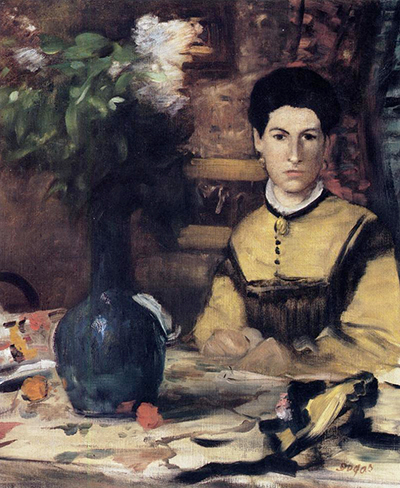The painting Madame De Rutte belongs to a small collection of portrait paintings by the artist Edgar Degas.
The artist was more interested in illustrating the stunning imagery of scenes of ballet, rather than individual people. Degas enjoyed capturing scenes, instead of creating them as they actually were. He attended many ballet performances in which he retained the scenes in his head and recreated them on canvas. However, seated portraits did not have this similar energy. Rather, they felt forced and did not have the magical feel of an artistic performance. Nevertheless, the portrait of Madame De Rutte influenced the artist to indeed create a portrait of a woman. It is unknown whether Degas was hired and paid for the piece, or if he thought of changing directions in his work.
Since Degas was such a prominent and marvellous painter of his time, it is predicted that many constantly asked for Degas to paint a portrait of them. This is most likely the case with Madame De Rutte, which is still a part of a private collection. The stunning oil on canvas piece showcases Madame De Rutte Seated in an upright position starring directly at the viewer. Her eyes quickly catch one's gaze and captivated the eyes she stairs deeply into them. The woman is neither smiling nor frowning, but rather has a serious look on her face. It could indeed be her eyebrows angling downwards that is creating this intimidating stare.
While her lips are slightly curved downwards, it is unaware if the muse is deliberately attempting to give off this frightening energy. Her dark eyes and features add to the vibe of the painting as the viewer feels threatened. It seems as if Degas places a light source to the left of the piece, in which to base shade and light on. It is evident that the left side of the woman's face is illuminated, while Degas contours the other side. The womanÕs hair is carbon black, with no detailing able to be spotted. The woman has fairly large ears that point upwards as theyÕre hidden by her dark hair. Madame de Rutte has classic Parisian features of dark eyes, pale skin, and a pointy nose. The woman is dressed in a yellow and black dress. Small black bottoms are placed in the middle, going into a necklace. While the woman's face is perfectly centre, it seems as if her body is gently curving in the direction of the vase. The woman's dress has large puffy sleeves that fall towards her hands.
Degas decided to use impeccable detail on the woman's face yet did not do the same in the remainder of the piece. The woman's hands are painted in a nude shade, yet are then merged as one item. The other half of the painting is taken up by a large vase that stands on the table in which the woman is seated. This midnight blue vase holds light pink flowers that seem to resemble hydrangeas. Dark green leaves fill the surrounding area in the vase. On top of the table, small red and orange details fill the table that seem to resemble fruits and flowers. Alongside, the woman's hat lays on the table in matching yellow and black shades. It's evident that she took it off to pose for the artist. Rather than solemnly creating the piece as a portrait, the artist focuses immensely on other aspects such as the vase and items on the table.




